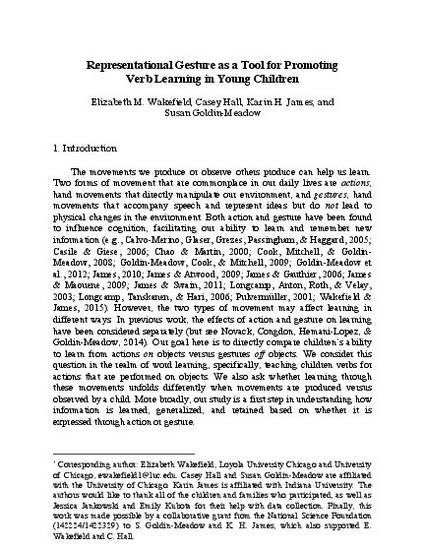
The movements we produce or observe others produce can help us learn. Two forms of movement that are commonplace in our daily lives are actions, hand movements that directly manipulate our environment, and gestures, hand movements that accompany speech and represent ideas but do not lead to physical changes in the environment. Both action and gesture have been found to influence cognition, facilitating our ability to learn and remember new information (e.g., Calvo-Merino, Glaser, Grezes, Passingham, & Haggard, 2005; Casile & Giese, 2006; Chao & Martin, 2000; Cook, Mitchell, & GoldinMeadow, 2008; Goldin-Meadow, Cook, & Mitchell, 2009; Goldin-Meadow et al., 2012; James, 2010; James & Atwood, 2009; James & Gauthier, 2006; James & Maouene, 2009; James & Swain, 2011; Longcamp, Anton, Roth, & Velay, 2003; Longcamp, Tanskanen, & Hari, 2006; Pulvermüller, 2001; Wakefield & James, 2015). However, the two types of movement may affect learning in different ways. In previous work, the effects of action and gesture on learning have been considered separately (but see Novack, Congdon, Hemani-Lopez, & Goldin-Meadow, 2014). Our goal here is to directly compare children’s ability to learn from actions on objects versus gestures off objects. We consider this question in the realm of word learning, specifically, teaching children verbs for actions that are performed on objects. We also ask whether learning through these movements unfolds differently when movements are produced versus observed by a child. More broadly, our study is a first step in understanding how information is learned, generalized, and retained based on whether it is expressed through action or gesture.
© Cascadilla Press 2017
Available at: http://works.bepress.com/elizabeth-wakefield-connell/8/

Author Posting. © Cascadilla Press 2017. This article is posted here by permission of Cascadilla Press for personal use, not for redistribution. The article was published in the Proceedings of the 41st annual Boston University Conference on Language Development, ed. Maria LaMendola and Jennifer Scott, 2017, http://cascadilla.com/bucld41toc.html